Related Research Articles

Samson was the last of the judges of the ancient Israelites mentioned in the Book of Judges and one of the last leaders who "judged" Israel before the institution of the monarchy. He is sometimes considered as an Israelite version of the popular Near Eastern folk hero also embodied by the Sumerian Gilgamesh and Enkidu, as well as the Greek Heracles. Samson was given superhuman powers by God in the form of extreme strength.

In the Book of Genesis, Tamar was the daughter-in-law of Judah (twice), as well as the mother of two of his children: the twins Perez and Zerah.
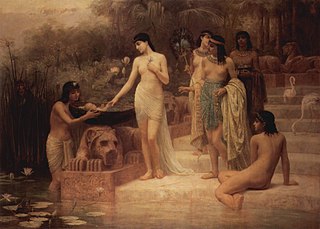
Shemot, Shemoth, or Shemos is the thirteenth weekly Torah portion in the annual Jewish cycle of Torah reading and the first in the Book of Exodus. It constitutes Exodus 1:1–6:1. The parashah tells of the Israelites' affliction in Egypt, the hiding and rescuing of the infant Moses, Moses in Midian, the calling of Moses, circumcision on the way, meeting the elders, and Moses before Pharaoh.

Beshalach, Beshallach, or Beshalah is the sixteenth weekly Torah portion in the annual Jewish cycle of Torah reading and the fourth in the Book of Exodus. It constitutes Exodus 13:17–17:16. In this parashah, Pharaoh changed his mind and chased after the Israelites, trapping them at the Sea of Reeds. God commanded Moses to split the sea, allowing the Israelites to escape, then closed the sea back upon the Egyptian army. The Israelites also experience the miracles of manna and clean water. And the Amalekites attacked, but the Israelites were victorious.
Tetzaveh, Tetsaveh, T'tzaveh, or T'tzavveh is the 20th weekly Torah portion in the annual Jewish cycle of Torah reading and the eighth in the Book of Exodus. The parashah reports God's commands to bring olive oil for the lamp, make sacred garments for the priests, conduct an ordination ceremony, and make an incense altar.

Tzav, Tsav, Zav, Sav, or Ṣaw is the 25th weekly Torah portion in the annual Jewish cycle of Torah reading and the second in the Book of Leviticus. The parashah teaches how the priests performed the sacrifices and describes the ordination of Aaron and his sons. The parashah constitutes Leviticus 6:1–8:36. The parashah is made up of 5,096 Hebrew letters, 1,353 Hebrew words, 97 verses, and 170 lines in a Torah scroll. Jews read it the 24th or 25th Sabbath after Simchat Torah, generally in the second half of March or the first half of April.
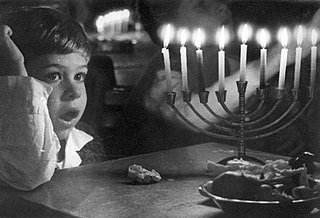
Naso or Nasso is the 35th weekly Torah portion in the annual Jewish cycle of Torah reading and the second in the Book of Numbers. It constitutes Numbers 4:21–7:89. The parashah addresses priestly duties, camp purification, restitution for wrongs committed, the wife accused of unfaithfulness, the nazirite, the Priestly Blessing, and consecration of the Tabernacle. Naso has the largest number of letters, words, and verses of any of the 54 weekly Torah portions. The parashah is made up of 8,632 Hebrew letters, 2,264 Hebrew words, 176 verses, and 311 lines in a Torah Scroll.
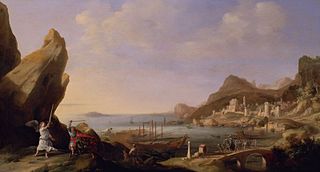
Balak is the 40th weekly Torah portion in the annual Jewish cycle of Torah reading and the seventh in the Book of Numbers. In the parashah, Balak son of Zippor, king of Moab, tries to hire Balaam to curse Israel, Balaam's donkey speaks to Balaam, and Balaam blesses Israel instead. The parashah constitutes Numbers 22:2–25:9. The parashah is made up of 5,357 Hebrew letters, 1,455 Hebrew words, 104 verses, and 178 lines in a Torah Scroll.
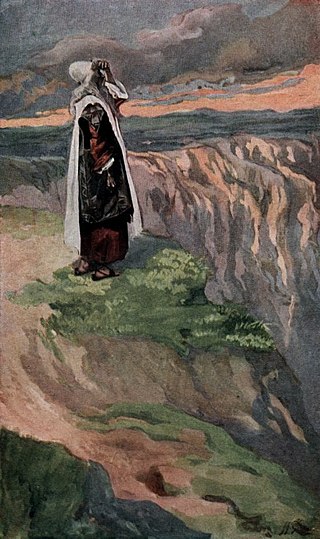
Pinechas, Pinchas, Pinhas, or Pin'has is the 41st weekly Torah portion in the annual Jewish cycle of Torah reading and the eighth in the Book of Numbers. It tells of Phinehas's killing of a couple, ending a plague, and of the daughters of Zelophehad's successful plea for land rights. It constitutes Numbers 25:10–30:1. The parashah is made up of 7,853 Hebrew letters, 1,887 Hebrew words, 168 verses, and 280 lines in a Torah scroll.

Devarim, Dvarim, or Debarim is the 44th weekly Torah portion in the annual Jewish cycle of Torah reading and the first in the Book of Deuteronomy. It comprises Deuteronomy 1:1–3:22. The parashah recounts how Moses appointed chiefs, the episode of the Twelve Spies, encounters with the Edomites and Ammonites, the conquest of Sihon and Og, and the assignment of land for the tribes of Reuben, Gad, and Manasseh.
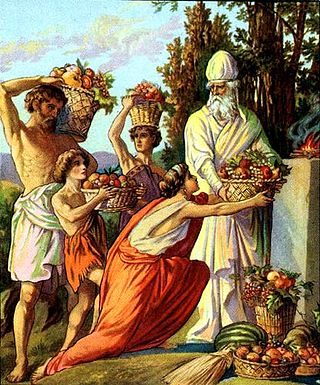
Ki Tavo, Ki Thavo, Ki Tabo, Ki Thabo, or Ki Savo is the 50th weekly Torah portion in the annual Jewish cycle of Torah reading and the seventh in the Book of Deuteronomy. It comprises Deuteronomy 26:1–29:8. The parashah tells of the ceremony of the first fruits, tithes, and the blessings from observance and curses from violation of the law.
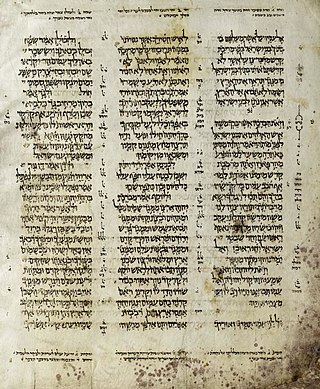
V'Zot HaBerachah, VeZos HaBerachah, VeZot Haberakha, V'Zeis Habrocho, V'Zaus Haberocho, V'Zois Haberuchu, Wazoth Habborocho, or Zos Habrocho is the 54th and final weekly Torah portion in the annual Jewish cycle of Torah reading and the 11th and last in the Book of Deuteronomy. It constitutes Deuteronomy 33:1–34:12. The parashah sets out the farewell Blessing of Moses for the 12 Tribes of Israel and concludes with the death of Moses.

Allusions in rabbinic literature to the Biblical character Noah, who saved his family and representatives of all the animals from a great flood by constructing an ark, contain various expansions, elaborations and inferences beyond what is presented in the text of the Bible itself.

Discussions in rabbinic literature of the biblical character Moses, who led the Israelites out of Egypt and through their wanderings in the wilderness, contain various expansions, elaborations and inferences beyond what is presented in the text of the Bible itself.

Allusions in Jewish rabbinic literature to the Biblical character Jethro, the father-in-law of Moses, contain various expansions, elaborations and inferences beyond what is presented in the text of the Bible itself.

Allusions in rabbinic literature to the Biblical character Job, the object of sufferings and tribulations in the Book of Job, contain various expansions, elaborations and inferences beyond what is presented in the text of the Bible itself.

Jewish mythology is the body of myths associated with Judaism. Elements of Jewish mythology have had a profound influence on Christian mythology and on Islamic mythology, as well as on Abrahamic culture in general. Christian mythology directly inherited many of the narratives from the Jewish people, sharing in common the narratives from the Old Testament. Islamic mythology also shares many of the same stories; for instance, a creation-account spaced out over six periods, the legend of Abraham, the stories of Moses and the Israelites, and many more.

In the Abrahamic religions, the voice of God is a communication from God to human beings through sound with no known physical source.
In Judaism, the Holy Spirit refers to the divine force, quality, and influence of God over the universe or over God's creatures, in given contexts.
Rabbi Isaac Nappaha, or Isaac the smith, was a rabbi of the 3rd-4th centuries who lived in the Galilee.
References
- ↑ Rosh Hashana 25a
- 1 2 Bava Batra 91a
- ↑ Numbers Rabba 10:13
- 1 2 Sotah 10a
- ↑ Genesis Rabbah 98:18
- ↑ Sotah 9b
- ↑ Genesis Rabba l.c. § 19
- ↑ Genesis 49:17
- ↑ Genesis Rabba l.c. §§ 18-19
- ↑ Leviticus Rabbah 8:2
- ↑ ib.; Sotah 9b
- ↑ Ecclesiastes Rabbah 1, end
- ↑ Leviticus Rabbah 23:9
- ↑ "The Eleventh Plague footnote 12 "...'I am the Lord' implies: I am He who inflicted punishment upon Samson, Amnon, and Zimri, and who will inflict punishment upon any one who will act in accordance with their practices..."". 24 June 2009.
- 1 2 Sotah l.c.
- ↑ Response of Rabbi Eliezer Zalmanov 08/19/2022
- ↑ Genesis Rabba l.c. § 18
- ↑ Compare Judges 15:20, 16:31
- ↑ Numbers Rabbah 9:25
- ↑ Compare Judges 16:17
- ↑ Judges 16:30
- ↑ Genesis Rabbah l.c. § 19
![]() This article incorporates text from a publication now in the public domain : Singer, Isidore; et al., eds. (1901–1906). "Samson". The Jewish Encyclopedia . New York: Funk & Wagnalls.
This article incorporates text from a publication now in the public domain : Singer, Isidore; et al., eds. (1901–1906). "Samson". The Jewish Encyclopedia . New York: Funk & Wagnalls.
